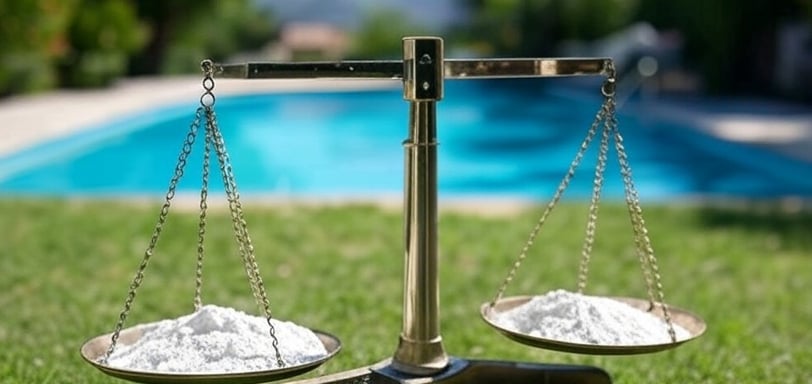Understanding the Importance of Water Balance and the Langelier Saturation Index (LSI)
Maintaining proper water balance in your swimming pool isn’t just about keeping the water clear—it’s about ensuring the longevity of your pool surfaces and equipment while providing a safe, comfortable swimming environment. One essential tool for achieving this is the Langelier Saturation Index (LSI). This guide will help you understand what LSI is, the factors influencing it, and why sticking to range-bound chemistry recommendations can sometimes lead to unbalanced water.
WATER BALANCETESTING
3 min read


What is the Langelier Saturation Index (LSI)?
The Langelier Saturation Index (LSI) is a scientific tool used to measure whether your pool water is balanced, corrosive, or scale-forming. Developed by Dr. Wilfred F. Langelier in the 1930s, the LSI was originally created to assess the scaling or corrosive potential of water in industrial systems like boilers and pipes. Over time, it has become a cornerstone of pool maintenance, offering a practical way to measure and adjust water chemistry for optimal conditions.
Balanced Water: Neither aggressive nor scale-forming, balanced water protects pool surfaces and equipment while providing a pleasant swimming experience.
Corrosive Water: If LSI is too low, the water aggressively seeks to balance itself by leaching minerals from pool surfaces, causing corrosion and damage.
Scale-Forming Water: If LSI is too high, excess minerals can precipitate out of the water, forming scale deposits on surfaces and equipment.
The goal is to keep your water slightly on the positive side of balanced (an LSI score between 0.0 and +0.3 is ideal).
Factors That Influence LSI
LSI is calculated based on multiple water chemistry parameters that interact with each other. These include:
pH
Impacts how acidic or basic your water is. Ideal range: 7.2 to 7.8.
Calcium Hardness
Measures the amount of dissolved calcium in the water. Ideal range: 200-400 ppm.
Total Alkalinity
Acts as a buffer for pH, preventing drastic swings. Ideal range: 80-120 ppm.
Water Temperature
Warmer water increases the likelihood of scale formation, while cooler water can contribute to corrosiveness.
Total Dissolved Solids (TDS)
Measures all dissolved substances in the water. Higher TDS can increase the scale-forming tendency.
Cyanuric Acid (CYA)
Stabilizes chlorine but can reduce alkalinity’s effectiveness in buffering pH.
LSI calculates the interactions between these factors, providing a comprehensive view of your water’s balance.
The Effects of Unbalanced Water
When your pool water is out of balance, it can lead to costly and frustrating issues:
Corrosive Water:
Damages pool surfaces, including plaster and vinyl liners.
Corrodes metal equipment like ladders, pumps, and heaters.
Causes etching of tiles and grout.
Scale-Forming Water:
Leaves unsightly white or gray deposits on pool surfaces.
Reduces efficiency and lifespan of equipment by clogging pipes and heat exchangers.
Makes cleaning and maintenance more difficult.
Why Range-Bound Chemistry Can Lead to Imbalance
Traditional water maintenance often focuses on keeping each parameter (pH, alkalinity, etc.) within its ideal range. However, this range-bound approach can result in water that is technically "in range" but still unbalanced according to LSI.
For example:
If pH is at the upper end of the range (7.8) and calcium hardness is also high, your water may be scale-forming.
Conversely, if pH and alkalinity are both low, your water could become corrosive, even if these values are "in range."
Using LSI ensures you’re considering the combined effects of all factors, not just isolated parameters.
Testing and Managing LSI
To manage LSI effectively, you’ll need regular water testing and a reliable tool or app to calculate the index. Here’s how to get started:
Test Key Parameters:
pH, Calcium Hardness, Alkalinity, and Cyanuric Acid can be measured with typical reagent-based test kits (like the ubiquitous blue box Taylor Technologies test kit)
Total Dissolved Solids (TDS) can be measured with a special-purpose digital meter
Temperature is done with any style of thermometer (analog or digital)
Use a Pool LSI Calculator:
Many free apps or professional pool testing kits include LSI calculators. One of the best out there is https://www.orendatech.com/pool-dosing-calculator
Input your water chemistry values, and the tool will calculate your LSI score.
Adjust Accordingly:
To reduce corrosiveness, increase alkalinity or calcium hardness as needed.
To lower scale-forming tendencies, reduce pH or dilute the water to lower calcium hardness.
Conclusion
The Langelier Saturation Index is an invaluable tool for maintaining a healthy, well-balanced pool. By focusing on the interplay between factors like pH, calcium hardness, and temperature, you can prevent the costly effects of unbalanced water. While managing LSI may seem complex at first, consistent testing and adjustments will ensure your pool remains a safe, enjoyable space for years to come.
Need help analyzing your pool’s LSI or addressing a water imbalance? SwimReady is here to guide you with expert advice and professional water care services. Contact us today to learn more!
© 2024 SWIMREADY LLC. All rights reserved.


Call or Text
